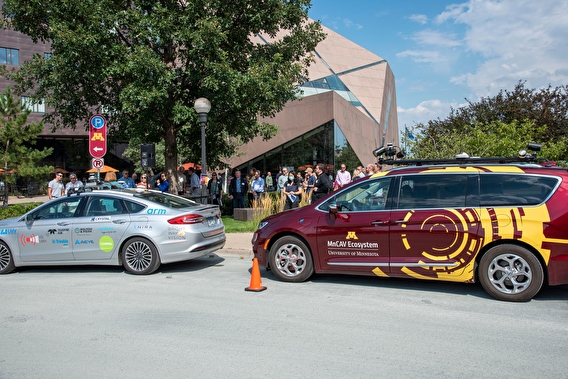
How ready is Minnesota for connected and automated vehicles (CAVs)? Last August, researchers took a four-day, 1,086-mile trip around the state to find out. A newly published report details the team’s findings for transportation professionals and agencies as they consider how to make improvements to our transportation infrastructure for automated vehicles and driving.
Many new autos already use automated features such as blind-spot monitoring, adaptive cruise control, and lane keeping. These features depend on cameras and other onboard technologies that allow vehicles to “see” the environment around them and adjust accordingly. Report authors suggest that roadway infrastructure and environmental conditions are critical to predictable and safe operation not only as this technology becomes more prevalent and advanced, but also for current drivers of traditional vehicles.
Staff from CTS, VSI Labs, Bolton & Menk, and project sponsor MnDOT piloted two research CAVs in “dark mode,” which disables automated driving features and gives full control to people. This allows onboard systems to focus entirely on data collection.
“The driving team experienced nearly every condition Minnesota roads have to offer,” says Gina Baas, associate director of CTS. The diverse route included two-, four-, and six-lane asphalt and concrete roadways, 135 traffic signals, 8 roundabouts, 6 J-turn intersections, and several work zones as well as fog, glare, and other environmental conditions.
The team organized the review of the state’s roadway infrastructure into seven categories. Deficient conditions were noted most frequently in these four:
- Freeway ramps and turn lanes
- Poor lane line condition and visibility
- Construction and maintenance activities
- Poor contrast
Edge stripes that are faded or lack sufficient contrast with lighter colored pavements can be virtually invisible to cameras and cause misdetections. A lack of continuous lane striping—such as at the gaps on freeway exit ramps—can cause automated vehicles to follow an unintended course. In work zones, old lane markings, scarrings, or other visual effects—such as straight lines caused by crack sealer—can also cause misdetections.
These conditions were less prevalent but also caused misdetection:
- Tight curvature—Dramatic curves can affect lane recognition.
- Environmental issues—Fog, glare, precipitation, or heavy shadows can hamper visibility.
- Dynamic lanes—Unique pavement markings can lead to differing outcomes.

In a presentation to the Governor’s Advisory Council on CAVs, Phil Magney of VSI Labs, Ross Tillman of Bolton & Menk, and Baas provided summary findings accompanied by compelling video visualizations using data from the research vehicles. These videos bring to life examples of deficient conditions from the categories above.
“This research project gathered a wealth of data that helps us understand how Minnesota roads work with automated vehicle technology being used today, and as expected, there are many challenges still yet to overcome,” says Tara Olds, director of MnDOT’s Connected and Automated Vehicle Office. “This information is valuable for agency professionals in planning, designing, and maintaining roadways across Minnesota for the capabilities and limitations of future technologies.”
The report also details the project purpose, approach, and engagements with dozens of local officials and residents at Drive MN tour stops in Saint Cloud, Duluth, Bemidji, Moorhead, Marshall, Mankato, Winona, and the Twin Cities metro area.
Writer: John Siqveland


